HIV or the human immunodeficiency virus is a lentivirus that causes HIV infection. An unmanaged infection can lead to a condition called acquired immunodeficiency syndrome or AIDS in which other life-threatening opportunistic infections and cancers thrive because of the progressive failure of the immune system. Take note that treating AIDS requires treating HIV infection. However, the virus is hard to kill because of several reasons. Hence, AIDS is also hard to cure.
Why HIV Infection is Hard to Cure: Major Reasons Why HIV is Hard To Kill
There are two major reasons why HIV infection is hard to cure or why the virus is hard to kill. Central to these reasons is the fact that HIV is very resilient against natural immune response and available therapies. Take note of the following:
1. The Virus is Very Elusive Because it Readily Mutates
Popular explanations describe HIV as a master of disguise. An article by John R. Mascola and David C. Montefiori noted that one of the two types of human immunodeficiency virus called HIV-1 readily mutates to escape the immune system and evolves further to thwart off attacks by immune cells. Note that HIV-1 is the most prevalent cause of HIV infection in the world.
To be specific, HIV-1 uses a shield of continually shifting sugar molecules called glycans to prevent antibodies from attacking. This is one of the possible reasons why candidate HIV-1 vaccines remained ineffective.
Researchers Adam S. Dingens et al. further explained that like any other virus, HIV-1 has a protein called library envelope or Env that covers its surface. The immune system would naturally use this Env to tag and recognize the virus. However, this protein mutates rapidly, thus allowing HIV to slip away from immune recognition.
The rapid adaptability of the virus stems from its underlying biological mechanism. HIV is a single-stranded RNA virus that uses an enzyme called reverse transcriptase to replicate its genome from several RNA bases of other HIVs. This replication via reverse transcriptase is rapid and random, thus producing a large number of distinct copies. Note that viral recombination produces genetic variation.
Replications over a period create a pool of diverse HIV strains or copies called quasi-species. Some HIV copies are highly functional and very infectious while others are partly to slightly infectious. There are also HIV copies that are mere junk. The immune system has to respond to all of these genetically diverse copies regardless of their degree of infectiousness, thus leaving it overstrained.
2. The Virus Attacks Helper T-Cells and Impairs the Immune System
Another reason why HIV infection is hard to cure is that HIV attacks the immune system itself. Remember that the immune system, especially the innate immune system and the adaptive immune system, provide natural defense against pathogens and foreign objects such as allergens. Most viral infections would not survive this defense mechanism of the human body.
However, one of the targets of HIV is a type of cells called CD4+ T cells or helper T cells. These cells play an important role in the immune system and adaptive immunity because they are responsible for coordinating the activities of other immune cells such as B cell antibody class switching, cytotoxic T cell activation and growth, and regulating the bactericidal activities of phagocytes.
Different types of immune cells are constantly communicating with one another to coordinate their activities, thus forming overlapping networks. Helper T Cells are at the center of most of these networks. They specifically work by relaying instructions to different groups of immune cells such as by telling killer T cells to target a pathogen or ordering B cells to make antibodies.
Because HIV infects and replicates within helper T cells, apart from other types of immune cells such as macrophages and dendritic cells, an HIV infection disrupts most of the overlapping networks of the immune cells and thereby, important immune processes. The immune cells are essentially left without instructions of what to do. This impairment leads to the further replication of HIV in the human body.
Remember that helper T cells orchestrate the immune system by controlling other T cell subsets, B cells, and innate immune responses. These are the reasons why an HIV infection also results in the development of AIDS. HIV generally weakens the immune system and causes the body to become susceptible to opportunistic infections and cancer proliferation.
3. The Ineffectiveness of Vaccines and Anti-Viral Drugs in Curing HIV Infection
Current research in vaccine developments and the corresponding candidate vaccine products remain ineffective in curing HIV infection because of the rapid adaptability of the virus and its immunosuppressing impacts. Treatment through vaccination and adaptive immunity are still impossible.
Drugs are another treatment option. However, unlike bacteria, a virus does not respond well to drugs in general. Note that antibiotics only work against bacteria but not viruses. Both pathogens are structurally different. While some classes of anti-viral drugs have been effective in curing other types of viral infections, vaccination and adaptive immunity remain the best treatment option.
In the case of an HIV infection, specific drugs called antiretroviral drugs have been developed and prescribed not to kill HIV but to control its replication, suppress its activity, maintain the function of the immune system, and prevent the development of AIDS. It is important to note that these drugs are not a cure. Furthermore, HIV can also develop resistance against several classes of antiretroviral drugs.
Other options for curing HIV infection include stem cell therapy and genome editing. However, economic, political, and social factors serve as barriers for promoting or expediting research and development of novel therapeutic options.
REFERENCES AND FURTHER READINGS
- Dingens, A. S., Haddox, H. K., Overbaugh, J., and Bloom, J. D. 2017. “Comprehensive Mapping of HIV-1 Escape from a Broadly Neutralizing Activity.” Cell Host and Microbe. 21(6): 777-787. DOI: 10.1016/j.chom.2017.05.003
- Mascola, J. R. and Montefiori, D. C. 2003. “HIV-1: Nature’s Master of Disguise.” Nature Medicine. 9:393-394. DOI: 10.1038/nm0403-393
